Monogram 1/48 P-40B
Modeling Madness re-published this article from 13 years ago, and I thought you might like to see it with all the photos I took that were not used there.
THE FLYING TIGERS
In the sixty years since the Second World War, the American Volunteer Group has become one of the truly legendary fighting organizations of that war. Over the years, many would believe the "Flying Tigers" - as they came to be known through articles posted by correspondents during the fighting over Rangoon in December 1941 - had fought in China against the Japanese for years before the attack on Pearl Harbor. In truth, they did not arrive in Burma until August, 1941 and their first operational mission was not flown until December 10, 1941, after Pearl Harbor; their first combat mission - intercepting the first bombing raid by the Japanese Army Air Force against Rangoon - was on December 23, 1941.
In 1941, China had been at war with the Empire of Japan since 1937, and was close to exhaustion. By 1940, the Japanese had uncontested aerial supremacy over China, and were bombing undefended Chinese cities at will, with great loss of life. In April 1941, President Roosevelt signed an unpublicized executive order authorizing recruitment of enlisted men and reserve officers on duty with the U.S. armed forces, and the British released 100 Lend-Lease Curtiss H-87-A2 "Tomahawks" for transfer to China. With U.S.-Japanese relations in a delicate position, the recruiting officers for the American Volunteer Group had to offer contracts that were "legally consistent" with official U.S. policy. While the operation had the blessing of the government, it was ostensibly organized by the Central Aircraft Manufacturing Company (CAMCO), run by Edward D. Pawley, who was later described by Life magazine as "always able to be at the right place a few minutes before the right time." The contracts made no mention of the true nature of the service, stating that the signatories were hired to "manufacture, repair and operate aircraft."
The original plan covered three groups of volunteers: two fighter groups and one bomber group. The first group would be equipped with Curtiss P-40s, while the next would have Seversky P-43s; the third - a bombardment group - was to be equipped with Lockheed Hudsons. The Japanese attack on Pearl Harbor forced the cancellation of the second and third groups.
As Erik Shilling remembered, the group sailed from San Francisco on the Dutch steamer Jagersfontein. "North of Hawaii, we were joined by the American heavy cruisers Salt Lake City and Northampton, which escorted us as far as the Java Sea, since the Japanese had announced they knew we were on our way to China and had vowed we would never arrive." Once in the Java Sea, Jagersfontein was on her own, stopping for a day in Singapore before proceeding to Rangoon, where she docked in early August, 1941. The American Volunteer Group had arrived. While the British had decided to support them, the political situation in southeast Asia was delicate; the Tigers had to "disappear," and their destination was a jungle airfield 100 miles north of Rangoon, known as Toungou.
During training at Toungou, three squadrons were organized: the "Adam and Eves" (the first pursuit), the "Panda Bears," and the "Hells Angels." As member of the third squadron, Erik Shilling ended up creating the insignia that would forever be linked with the Flying Tigers. "It's always been said that the tiger mouth came about after we saw a picture of a P-40 being flown by 112 Squadron in North Africa," Shilling recalled to me in his last interview before his death in March 2002. "That's not true. I was looking through a British magazine one day and saw a photo of an Me-110 with a shark face on it. They were the 'Haifisch Gruppe.' I thought it looked perfect for our squadron insignia." Shilling chalked a sharkmouth on his P-40 to see how it might look; when he asked Chennault for permission to use it as a squadron marking, Chennault saw it as the group marking. Shilling ended up chalking the sharkmouth on all of the P-40s at Toungou before they were painted. "That's why there were no two of them with the same mouth."
When war came to the Pacific on December 8, 1941, only the guns on the "Hells Angels" planes had been installed and boresighted, readying them for combat. Following the information gained from Erik Shilling's December 10 reconnaissance flight over the Japanese airfields at Bangkok, Chennault withdrew the other two squadrons to Kunming, China, where they could be fully equipped. The "Hells Angels" moved down to Mingaladon airdrome outside Rangoon, to defend the port with the Brewster Buffaloes of 67 Squadron, RAF.
The AVG was first blooded outside Kunming on December 20, 1941. Ten Ki.21 "Sally" bombers were spotted heading for the city. Jack Newkirk's lead flight from the 2nd "Panda Bear" squadron was scrambled, covered by the "Adam and Eves" of the first squadron. Ed Rector was the first Tiger to shoot down an enemy aircraft when he blew up one of the Ki.21s. Newkirk's radio failed at that moment; Rector and the others followed him home while the "Adam and Eves" shot down five more bombers, forcing them to turn back before bombing the city. Chennault's response on hearing that six of ten were claimed was "next time, get them all." In March 1942, it was discovered three more of the bombers had failed to return, making the AVG's first score nine of ten.
Charles Older And The Hells Angels Over Rangoon:
A multi-generation native Angeleno, Charles H. Older, Jr. graduated from UCLA in 1939. With war clouds gathering, he decided not to go on to UCLA Law School and entered the NavCad Program, where he was commissioned a 2nd Lieutenant in the Marine Corps in 1940. He was assigned to VMF-1, based at Quantico and flying the Grumman F3F-2, which he considered "an obsolete toy, with terrible landing gear." In 1941, the unit - now known as VMF-111 - was equipped with the Grumman F4F-3 "Wildcat." While flying his Wildcat from the Grumman factory on Long Island to Quantico, Older first made the acquaintance of the P-40. "One of the squadrons from Mitchell Field was up," Older recalled, "and two of them decided to jump me. The P-40 struck me as quite an airplane, since it was faster and more maneuverable than what I had." Older also hated the Wildcat for its narrow, dangerous landing gear, a fault he also held against the P-40 when he finally flew it. "The only real fighter we ever had in the entire Second World War was the Mustang," he recalled. "The P-51 was perfect. It had landing gear that wouldn't make you crash if you were in trouble, it could fly to where the enemy was, and could outfly anything they had. I loved it."
As with most fighter pilots, Older remembers his first combat mission with more clarity than any other. That was the interception of the Japanese bombers on December 23, 1941. "Ken Jernstedt and I had been waiting to see if the Japs were coming that morning. When they didn't, we decided to bicycle into Rangoon. Just as we got to the front gate there at Mingaladon, we heard the sirens go off. We rode back two miles as fast as we could. When we got back to the squadron, everyone had already taken off, but we found two P-40s still there. We got them started and took off. We didn't know where the others had gone, didn't have any idea where the enemy was, but we headed southeast after we flew over the city, since we figured that was most likely."
Headed their way were 40 Ki.21 Sally bombers of the 7th and 10th Air Groups, escorted by 12 Ki.27 Nate fighters of the 77th Sentai and eight brand new Ki.43-I Oscar fighters - the newest fighter of the J.A.A.F - of the 59th Sentai. The Oscars were initially identified by the AVG pilots as Zeros, which Chennault had briefed them on; it was many years before any of the group would agree they had not been up against the Japanese Navy in the fighting over Rangoon, and to this day one can get in trouble with Older for suggesting otherwise.
"We finally spotted the others ahead of us and higher. At about the same time, we saw the Japanese bombers heading for the city, and they were just about at our altitude. The others attacked and we didn't think we had time to climb higher, so we just poured the coals to our planes and went at them." Jernstedt and Older each exploded a Ki.21 on their first pass. As they and the others who attacked simultaneously pulled out, Neil Martin's P-40 was hit by one of the engines of the exploding bombers and he was forced to bail out.
"What I should have done then was dive to gain speed, then zoomed back up for another pass. But in the heat of battle you don't always remember orders. Ken and I turned and made another pass at them at their own level, but this time the gunners were ready for us, and they let us have it good. As the tracers were flying past, I realized this wasn't how we were supposed to do it, so we both dove away and then zoomed back above."
As Older and Jernstedt positioned themselves for a second attack, a Japanese gunner took aim at the P-40 flown by Hank Gilbert - at 21, the youngest of the AVG pilots - and exploded the airplane. At the same moment, Older made his second attack and claimed his second victory, another Ki.21. By this time, the battle had broken up in confusion. Two Ki.43s hit Paul Greene, forcing him to bail out.
The conclusion of the first fight in the Battle of Rangoon saw the Hells Angels claim six bombers and four fighters, though only six aircraft could be confirmed. 67 Squadron RAF claimed six, with four "probables." The Hells Angels had lost three P-40s and two pilots, while the RAF squadron had lost four Buffaloes with their pilots. With a few more "victories" like this, the defenders of Rangoon would be decimated.
Fortunately, the Japanese, stung by the unexpected stoutness of the resistance they encountered, called on the 5th Joint Air Group - then in the Philippines - to join up. Thus, they did not return until Christmas Day, which gave the defenders 48 hours to make repairs and ready themselves for the renewed assault.
The Christmas Day attack saw 71 Ki.21 bombers escorted by 40 fighters hit Rangoon. "We had noticed the first time that the bombers sped up as they headed into their runs, and the escort fell behind at that moment. We decided we would hit the escorts first and break them up, so they couldn't catch up to the bombers to defend them. We would hit them in a dive, then use our speed to catch the bombers undefended."
This time, the Japanese force flew out over the ocean and then turned back so they would be headed for home as they entered their bomb runs. Only 12 P-40s were able to take off, along with 18 RAF Buffaloes. With advance warning and the extra time the Japanese took flying around the city, the fighters managed to claw their way to 18,000 feet.
"We dove just about vertically on the fighters. I hit a Ki.27 that exploded, and went on through the formation. We used our speed to catch up to the bombers, zoomed up and dove on them. I got one bomber each on two runs. I was pulling out of my second attack when I saw another Jap fighter and exploded him."
With four victories on December 25th atop the two scored on December 23rd, Charles H. Older Jr. became the second ace of the American Volunteer Group (after Jack Newkirk's "ace in a day" performance over Kunming), and the third American to become an ace in the Pacific War after the five victories scored a week earlier by "Buzz" Wagner of the 17th Pursuit Group in the Philippines. He would score another four and a half kills during the desperate battles over the Salween River in March and April 1942, when the Japanese were prevented from invading southwestern China; had they been able to do so, China would have been knocked out of the war.
Charles H. Older Jr. had 10.5 victories at the time of the group's deactivation on July 4, 1942. Upon his return to the United States, he entered the USAAF as a Major and trained fighter pilots at Van Nuys Airfield until he returned to China in early 1944. As Deputy Commander of the 23rd Fighter Group, under the command of fellow Tiger "Tex" Hill, he led the descendants of the AVG to become the leading surviving ace of the China-Burma-India Theater, with 18.5 victories by the time he returned to the United States in February 1945; six - all Ki-84 "Franks" - were scored in one low-level mission over Hankow in September 1944, staged to counter the great Japanese offensive in China that fall. Charles Older became the only Flying Tiger to see combat in a second war when he flew B-26 Invaders in Korea with the California National Guard 452nd Bomb Group.
Following the Korean War, Older finally attended UCLA Law School and joined the California Bar in 1956. On January 23, 1972 - thirty years and one month to the day after scoring his first victories over Rangoon - Los Angeles Superior Court Judge Charles H. Older Jr., who had only been appointed to the bench by Governor Ronald Reagan one month before being assigned the case, sentenced Charles Manson and his followers to death for the sensational Tate-LaBianca murders. He retired from the court in 1987, and lived a short walk from his old Alma Mater in the Westwood district of Los Angeles, where I was fortunate to interview him in March, 2002. (He died in 2004)
THE KIT
I first built a Monogram P-40B in the summer of 1965, sitting in my college dorm room after returning from Vietnam that June. In the 38 years since, this has remained the one kit of the P-40B that is accurate in outline detail. I think over the years I probably built ten of them.
A few years ago, at a show, I bought a bunch of bagged kits, including a Monogram P-40B. Earlier this summer, I had cause to finally open the bag and take a look at what was inside. I immediately realized this was not the standard-issue Monogram kit I had dealt with for 30 years. It wasn't in olive drab, but was rather molded in a dark green plastic. In addition, there was a crispness to all the parts, and a sharpness to all the detail. All of a sudden, I remembered that P-40B built on my dorm desk those many years ago. This was a "first edition" kit. I test-fit the parts, and they all fit - easily! - something I didn't remember from the last kit I had built 20-odd years ago. I decided this was not going into the "parts box" it had originally been purchased for. Given that I had a resin cockpit for a P-35 (not that different) and a vacuform canopy for the kit from Squadron, I decided that if it turned out as good as it looked like it could, I would break into my stash of "Flying Tiger" decals and do it right.
CONSTRUCTION
Further examination and test-fitting revealed that this kit went together right. I started with the cockpit. The resin cockpit was from a Taiwanese company I've never seen since picking it up over at Smith Brothers Hobbies here in the San Fernando Valley some seven years ago. I painted and detailed it, and it looked good. After sanding off all the interior detail of the Monogram kit, I assembled the cockpit and glued together the fuselage halves. I then attached the nose part, and was amazed at how everything fit together so nicely that all I had to do was clean up joints with a #11 X-acto blade and apply Mr. Surfacer 500.
Moving to the wings, I glued the flaps in the closed position with some Evergreen sheet cut to use as internal stiffening. I assembled the wing, and glued it to the fuselage. Amazing! All I needed was some Mr. Surfacer along the wing-fuselage joint.
I then sanded down the whole model, lightly. I wanted to keep the rivet detail, sanded down sufficiently, since I had closely examined the only flyable P-40B in the world up close and personal during its four year restoration at Fighter Rebuilders out at Chino, and noted one could see the flush-riveted detail, and that not all of the airplane was flush-riveted. I then rescribed the panel lines with a #11 X-acto, and we were ready for the paint shop.
CAMOUFLAGE & MARKINGS
The AVG P-40s were painted in "US Equivalent" colors for RAF service. After pre-shading the model, I painted the lower surface "Sky Grey" using Tamiya's "Sky Grey." The upper camouflage was done with Gunze Sangyo "RAF Dark Earth" and "US Medium Green/FS 34092." I masked the "hard edge" camouflage with masking tape, running thread 1/8" inside the edge, to lift it. When this was all dry, I gave the model a good coat of Future.
I broke open the "AVG stash" and did Charles Older's airplane from the Aeromaster "AVG Special" decal sheet. Everything went down easily and looked good.
CONCLUSIONS
For those old enough to remember, this model proves you aren't senile to recall Monogram kits as "great." The original kits were. Great, that is. 35 years of popping them out of the same molds results in the "crappy kits" everyone thinks of today.
AIR-TO-AIR PHOTOS
These photos were taken in April 1998, when this airplane was first flown after restoration at Fighter Rebuilders. It was put in the temporary markings of Erik Shilling's airplane, since Erik was a long-time supporter of Planes of Fame Air Museum. The airplane was recovered from Russia, where it had crashed outside Arkangel and 1943. When the Russian paint was taken off, there was the OD/NG of a USAAC P-40C in the markings of the 77th Pursuit Squadron in 1941! The airplane was one of the 48 turned in in June 1941 by the 20th Pursuit Group to be replaced with P-40Ds. When the Soviet Union was invaded that month, Winston Churchill directed that 100 Tomahawk IIs on Lend-Lease be diverted to the USSR. Curtiss took the 48 USAAC airplanes (under a secret directive by FDR that all "old equipment" turned in by US armed forces should be turned over to Lend-Lease) and sent them on to Russia with 52 other RAF airplanes. This airplane currently resides at the Flying Heritage Collection in Washington state, and is in the markings of Jack Newkirk's airplane.
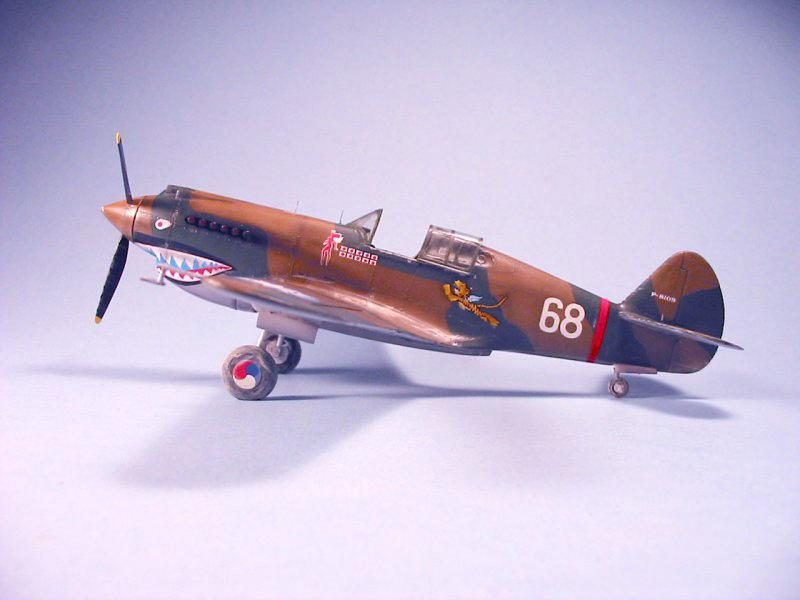

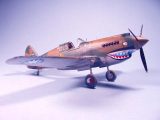
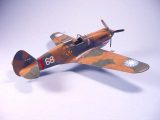
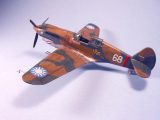
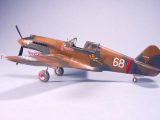
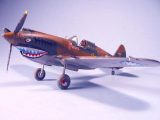
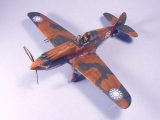
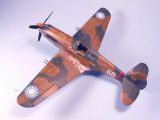
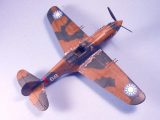
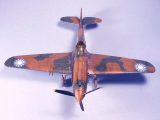
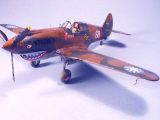
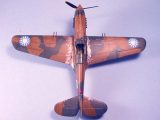
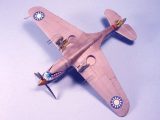
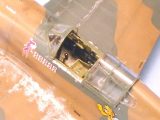

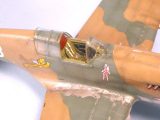

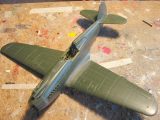
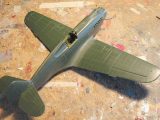


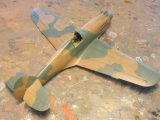
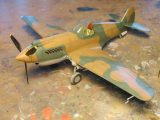
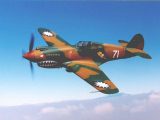
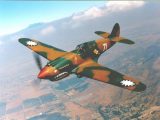
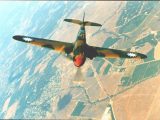
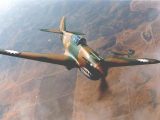

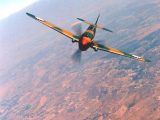
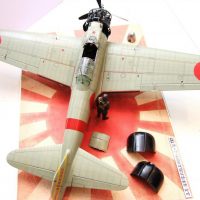
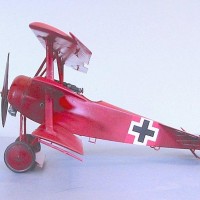
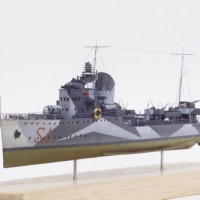
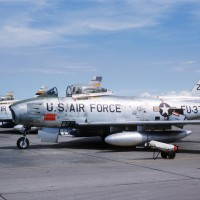
The restored P-40 with Erick Shillings cameo where did they get the info to paint that aircraft? Didn't the Flying Tigers fly with prop spinners that where either red,yellow or white? I recall that the Monogram instructions gave you that option? It's always neat to see a model that was designed with a slide rule and based from a wooden model. Then scaled down to create this classic.
Stephan, remember that Bob Scott changed the color of "Old Exterminator" spinner from time to time to make the Japanese think they had more planes. Wonder if that came from the AVG?
Always a shoestring outfit, at the end of a long pipeline, AKA the "aluminum trail".
The idea for the Shark mouth was a picture in The Illustrated London News, a British photo magazine like Life, or Look. The Haifisch Gruppe, flying BF110s in the Battle of Britain. 112 sqdn. may have seen the same photo. Sort of which came first, but interesting how some things got started.
They used photos to get the camo scheme and Eric gave them pictures of his airplane to do the markings.
They didn't use different-colored props until later. The instructions frfom 50 years ago didn't have that kind of information and knowledge base.
Tom, great writeup, every time I read one of your accompanying articles I learn things.
I remember when this kit came out, and it has been a favorite ever since. Other companies keep trying, and stepping on it. I'm hoping for the promised Airfix, myself. They've done well, lately.
I'd forgotten that it was molded in green initially, as was their P-39 and the FW-190.
I suspect they've recouped their investment, huh?
P-40s and the AVG have always been favorites, what a great story!
I'm looking at my copy of the 1964 Monogram P-40 instructions ...
They list the nose colors as red,yellow and camouflage.
Nice article as well as a well build model Tom. I just finished and posted a Monogram P-39 that had green plastic as well. It too went together very well.
Nice build and a very interesting article.
Thanks Tom.
An old monogram build i like.
Whoa! I know,I know! It's not up to the Standards of the Arifix kit; BUT, this OLD Monogram kits 'LOOKS' more like the real thing than ANY new release. PERIOD! It's too long here and too short there; but stands up to any AIRFIX build! Good show TC!
Now, Tamiya! Can you beat this 50 yrs old kit with a new 48th scale release? Prove it! Airfix didn't!
Bo